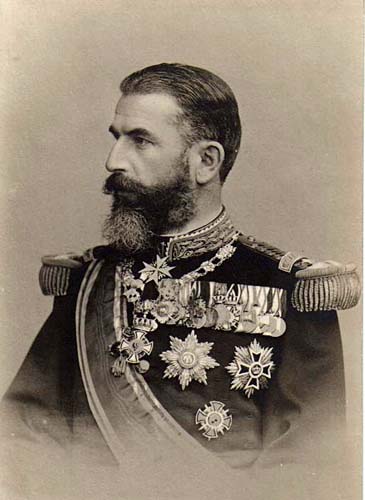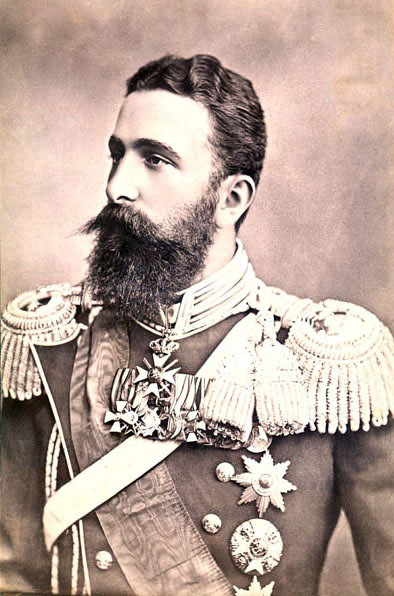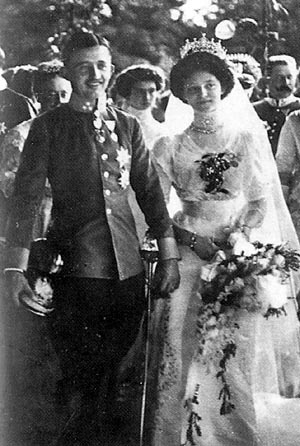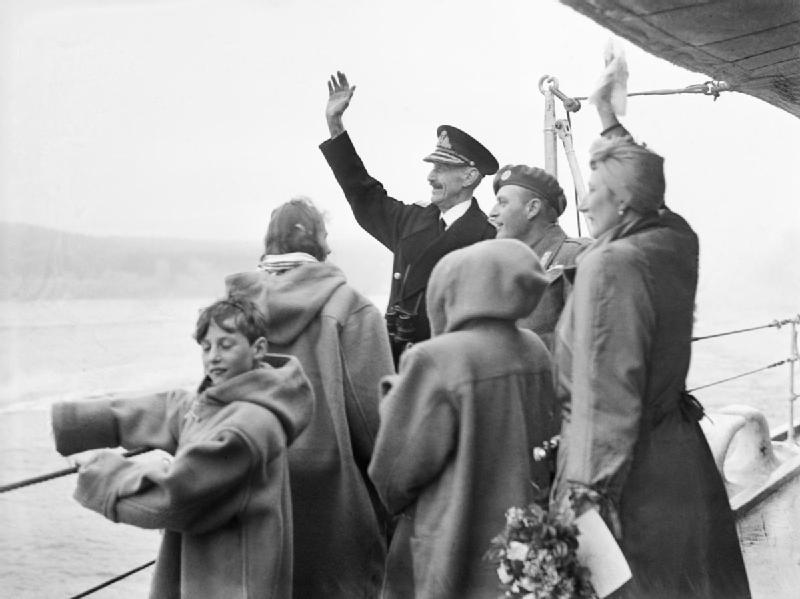by Susan Flantzer © Unofficial Royalty 2014

James Scott, 1st Duke of Monmouth; Credit – Wikipedia
Despite fathering many illegitimate children with his mistresses, King Charles II of England had no children with his wife Catherine of Braganza. King Charles II is an ancestor through his mistresses of many British aristocrats and of several women who married into the British Royal Family. Lucy Walter and King Charles II are ancestors of Sarah, Duchess of York and Princess Alice, Duchess of Gloucester. Barbara Palmer, Duchess of Cleveland and King Charles II are ancestors of Diana, Princess of Wales and Sarah, Duchess of York. Louise Renée de Penancoet de Kérouaille, Duchess of Portsmouth and King Charles II are ancestors of Diana, Princess of Wales, Queen Camilla, and Sarah, Duchess of York.
In 1648, Charles, Prince of Wales (the future King Charles II of England), the eldest son of King Charles I of England, traveled to The Hague, The Netherlands where his sister Mary, Princess Royal and her husband Willem II, Prince of Orange lived. Charles hoped to persuade them to contribute financially to the royalist cause in the Second English Civil War which ultimately ended with the beheading of King Charles I of England. While in The Hague, the 18-year-old Charles had a brief affair with Lucy Walter.
Lucy Walter was born around 1630 at Roch Castle near Haverfordwest, Wales to William Walter and Elizabeth Prothero. During the English Civil War, the Walter family supported the royalist forces and in 1644 Roch Castle was captured by the parliamentary forces and burned. The Walter family fled and Lucy found herself in London and soon set sail for The Hague where she met Charles. On April 9, 1649, Lucy gave birth in Rotterdam, then in the Principality of Orange, now in The Netherlands, to a son named James. Charles did acknowledge the child, but some thought that Colonel Robert Sidney, a younger son of the 2nd Earl of Leicester, was the father.
A DNA test in 2012 concluded that James’ descendant Richard Montagu Douglas Scott, the 10th Duke of Buccleuch, shared patrilineal DNA with a descendant of the royal Stuarts, proving that James Scott, Duke of Monmouth was the son of King Charles II of England. There was also a controversy over whether Charles had secretly married Lucy Walter. Their son claimed his parents had married, but King Charles II said the only woman he had ever married was his queen, Catherine of Braganza. Charles and Catherine’s marriage was childless, but Charles had at least 15 illegitimate children with his mistresses, and James was the eldest of Charles’ children.
When James was about nine years old, he was brought to Paris and placed in the care of his paternal grandmother Henrietta Maria of France, who had returned to her home country during the English Civil War. James lived in the household of William Crofts, 1st Baron Crofts who had followed Charles into exile after the execution of King Charles I of England. At this time, James took the surname Crofts. In 1662, two years after his father was restored to the English throne, James was brought to England.
On February 14, 1663, 14-year-old James was created Duke of Monmouth, Earl of Doncaster, and Baron Scott of Tinsdale. The next month, he was created a Knight of the Garter. On April 20, 1663, James married Anne Scott who was the 4th Countess of Buccleuch in her own right. On their wedding day, the couple was created Duke and Duchess of Buccleuch. Thereafter, James used Scott as his surname but was usually called Monmouth. The couple had seven children and Sarah, Duchess of York and Princess Alice, Duchess of Gloucester are among their descendants. For more details about the descendants of the Duke of Monmouth.
Children of James and Anne:
- Charles Scott, Earl of Doncaster (1672–1674), died in infancy
- James Scott, Earl of Dalkeith (1674–1705), married Lady Henrietta Hyde, daughter of Laurence Hyde, 1st Earl of Rochester and had six children including Francis Scott, 2nd Duke of Buccleuch. Laurence Hyde was the brother of Anne Hyde, Duchess of York, wife of James, Duke of York and Albany, later James VII of Scotland, II of England.
- Lady Anne Scott (1675–1685), died young
- Henry Scott, 1st Earl of Deloraine (1676–1730), married (1) Anne Duncombe, had three children (2) Mary Howard, had two children
- Lord Francis Scott (1678–1679), died in infancy
- Lady Charlotte Scott (born and died 1683), died in infancy

Anne, Duchess of Buccleuch and her sons; Credit – Wikipedia
At the age of 16, James began to serve in various military and government roles. He served in the Royal Navy under his uncle the Duke of York (the future King James II of England) and was captain of a horse troop of the 1st Life Guards. In 1670, James became a Privy Councilor. His father King Charles II sent James as an ambassador to Paris and Utrecht in 1672. That same year, he commanded British troops sent to help King Louis XIV of France (his father’s first cousin) in a campaign against the Dutch. Other roles included Lord High Chamberlain of Scotland, Master of the Horse, Chancellor of Cambridge University and Captain-General of all the land forces of England, Scotland, and Wales.

James, Duke of Monmouth commanding the British against the Dutch in 1672; Credit – Wikipedia
Because King Charles II had no legitimate children, his Catholic brother James, Duke of York was heir to the throne. In 1678, there was a popular outcry for a Protestant heir, and James, Duke of Monmouth was touted as that heir. King Charles II issued a proclamation that he had married only Catherine of Braganza to squelch the possibility that his son James was a legitimate heir. James was then sent out of England to Scotland to suppress an uprising. His success in Scotland only made James more popular, and he was sent to the Netherlands into temporary exile. When James returned to England, his popularity had not decreased and he was met with bonfires and bells ringing. King Charles II refused to see his son and deprived him of most of his positions. Charles ordered his son into exile, but James defied his father and went on a tour of the West Country to determine his support there. Over the next several years, there were several failed attempts at reconciliation between father and son. In 1683, James was used as a tool in the unsuccessful Rye House Plot to assassinate King Charles II and James, Duke of York. James was obliged to go into exile in the Netherlands and he was there when his father, King Charles II, died on February 6, 1685, and his uncle became King James II.
Upon his father’s death, James, Duke of Monmouth asserted his claim to the throne and planned an invasion of England and Scotland. He landed at Lyme Regis, Dorset, England on June 11, 1685, and proclaimed himself king on June 20, 1685. On July 6, 1685, the armies of uncle and nephew met at the Battle of Sedgemoor where the army of James, Duke of Monmouth was defeated. James had left the battlefield disguised as a peasant and was discovered hiding in a ditch three days later.
James, Duke of Monmouth had previously been attainted of treason by Parliament on June 16, 1685, and was to “suffer Paines of Death and Incurr all Forfeitures as a Traitor Convicted and Attainted of High Treason.” He groveled at the feet of his uncle King James II, begging for his life. James was sent to the Tower of London and beheaded on Tower Hill on July 15, 1685. It took several blows of the ax to behead him. 36-year-old James, Duke of Monmouth was buried in the Chapel of St. Peter ad Vincula at the Tower of London.
The Act of Attainder forfeited his English peerages, but his Scottish peerages were not affected and continued to be held by his widow and their descendants. The subsidiary titles of the Duke of Monmouth peerage were restored to Monmouth’s grandson, Francis Scott, 2nd Duke of Buccleuch. Ironically, King James II’s reign lasted only until 1688, when he was overthrown in the Glorious Revolution by his Protestant daughter Queen Mary II and his nephew and Mary’s husband King William III.
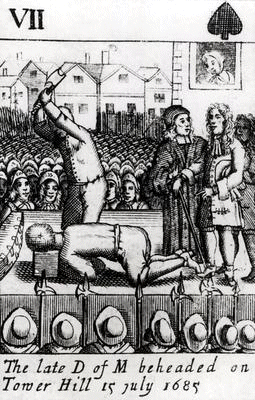
Execution of James, Duke of Monmouth; Credit – Wikipedia
This article is the intellectual property of Unofficial Royalty and is NOT TO BE COPIED, EDITED, OR POSTED IN ANY FORM ON ANOTHER WEBSITE under any circumstances. It is permissible to use a link that directs to Unofficial Royalty.
